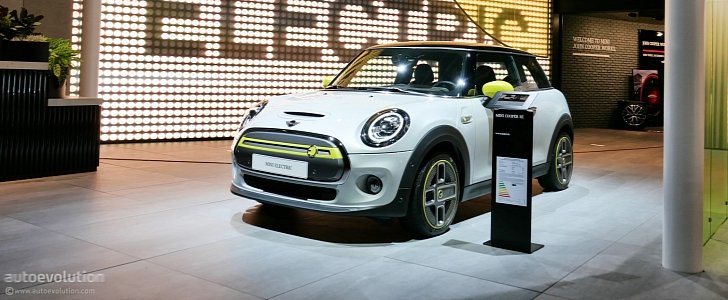Back when BMW didn’t have electric vehicles, the Germans debuted Project i and the i brand with the i3 concept in 2011. Field testing began a few years back with the MINI E, then the i3 rolled out in 2013 at the Leipzig assembly plant where the i8 is also manufactured.
BMW decided to return the favor to MINI for the E, and this is where the Cooper SE steps onto the scene. One of the most anticipated debuts of 2019 and the Frankfurt Motor Show is far less than the hype of the marketing talk would lead you to believe, but MINI has amassed close to 50,000 pre-reservations to carry through at the time of reporting.
Pricing in Germany and the United Kingdom starts at €32,500 and £27,900, and what you get in return is the three-door hatchback we all know and love with the electric motor from the i3s and a 32.6-kWh battery. Given that the BMW is a bit pricier thanks to CFRP and eucalyptus wood for the interior trim, you could say that MINI is an interesting addition to the EV onslaught we’re experiencing for a few years now thanks to Tesla.
On the other hand, it’s not. Hyundai has almost double the capacity to offer in the Kona Electric and the Ioniq Electric is much obliged to return 311 kilometers of range from 38.3 kWh while offering loads more space for passengers and luggage. The problem with the Cooper SE is simple. To the point, MINI tries to sell the premium-ness at a retail price that can’t compete with volume-oriented contenders such as the Kona and Ioniq.
If you still prefer the Cooper SE to the alternative from South Korea, then you’re treated to 181 horsepower (184 PS), 200 pound-feet (270 Nm) of torque, and an electric range of up to 270 kilometers (167 miles). Given these details, can MINI maintain the momentum as electric vehicles from other automaker keep getting better and more affordable?
In a nutshell, it’s possible. Even if the Cooper SE doesn’t prove to be a commercial success after the razzmatazz wears off, the BMW Group will certainly improve the design with the fifth-generation electric drive. The flexible architecture for all types of drivetrains promises up to 700 kilometers (435 miles) on a single charger for all-electric vehicles.
Given that MINI is responsible for one of the smallest vehicles in the BMW Group portfolio, it’s easy to predict that the successor of the Cooper SE will be much, much better.
Pricing in Germany and the United Kingdom starts at €32,500 and £27,900, and what you get in return is the three-door hatchback we all know and love with the electric motor from the i3s and a 32.6-kWh battery. Given that the BMW is a bit pricier thanks to CFRP and eucalyptus wood for the interior trim, you could say that MINI is an interesting addition to the EV onslaught we’re experiencing for a few years now thanks to Tesla.
On the other hand, it’s not. Hyundai has almost double the capacity to offer in the Kona Electric and the Ioniq Electric is much obliged to return 311 kilometers of range from 38.3 kWh while offering loads more space for passengers and luggage. The problem with the Cooper SE is simple. To the point, MINI tries to sell the premium-ness at a retail price that can’t compete with volume-oriented contenders such as the Kona and Ioniq.
If you still prefer the Cooper SE to the alternative from South Korea, then you’re treated to 181 horsepower (184 PS), 200 pound-feet (270 Nm) of torque, and an electric range of up to 270 kilometers (167 miles). Given these details, can MINI maintain the momentum as electric vehicles from other automaker keep getting better and more affordable?
In a nutshell, it’s possible. Even if the Cooper SE doesn’t prove to be a commercial success after the razzmatazz wears off, the BMW Group will certainly improve the design with the fifth-generation electric drive. The flexible architecture for all types of drivetrains promises up to 700 kilometers (435 miles) on a single charger for all-electric vehicles.
Given that MINI is responsible for one of the smallest vehicles in the BMW Group portfolio, it’s easy to predict that the successor of the Cooper SE will be much, much better.















